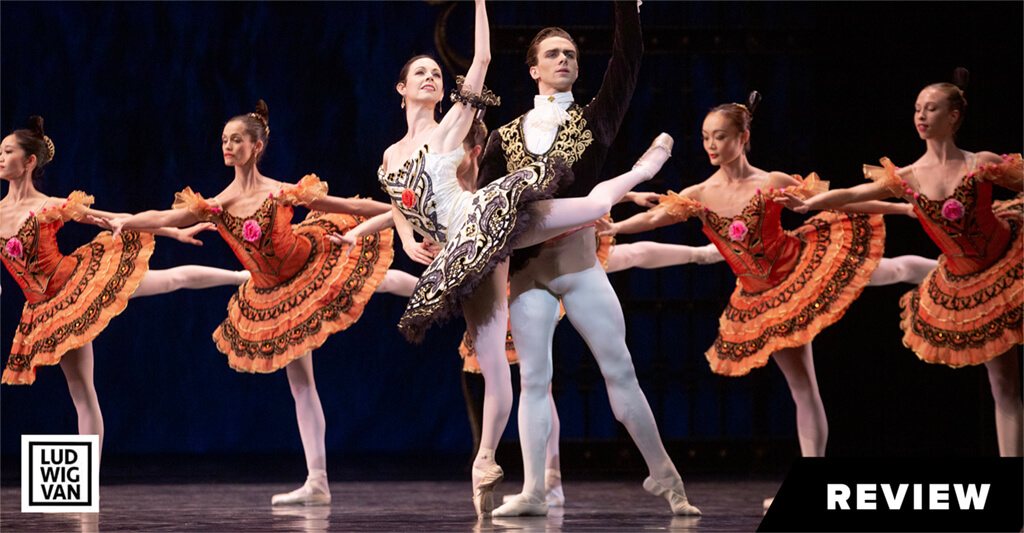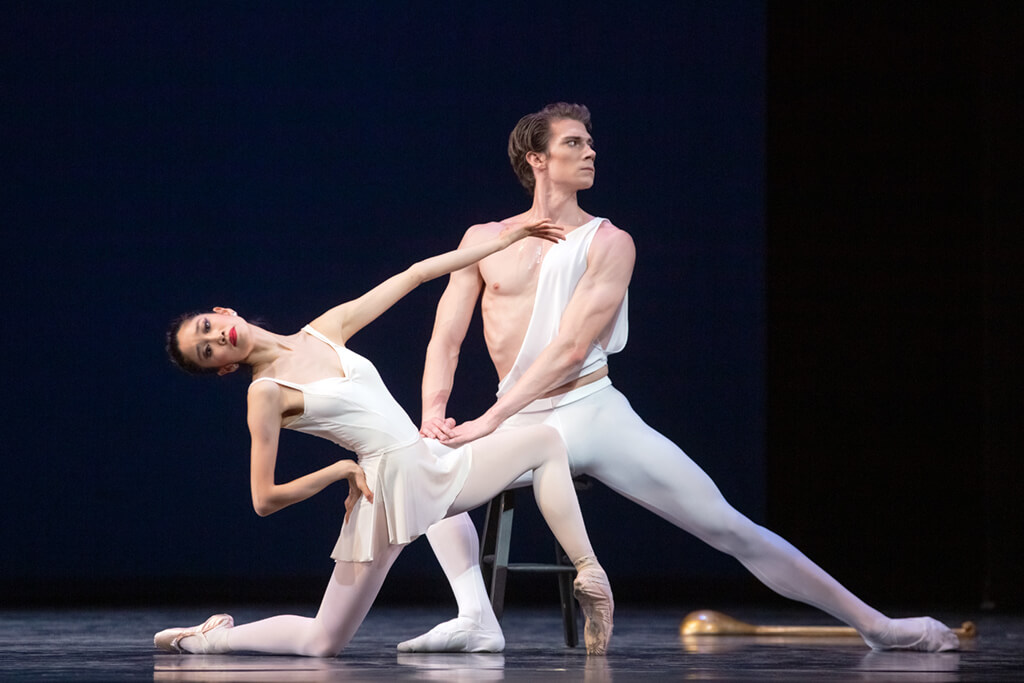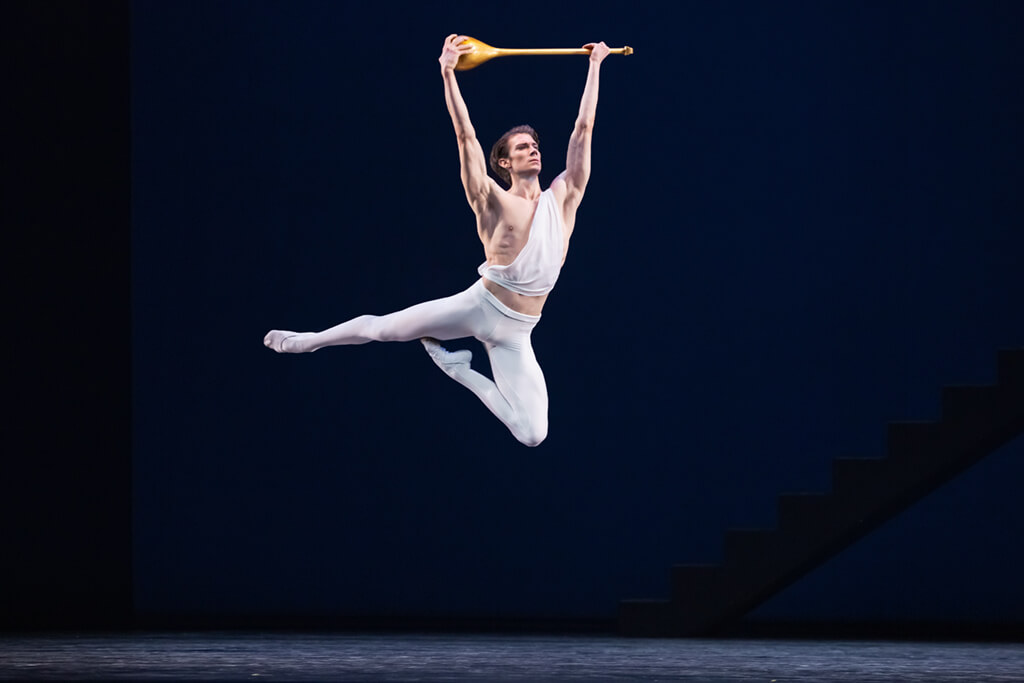
The National Ballet of Canada/Winter Mixed Program: Apollo, Night, The Sea Above, The Sky Below, Paquita, choreography by Balanchine, Adam, Binet and Stowell (after Petipa), Four Seasons Centre, Mar. 1 to 3, Mar. 20 to Mar. 21. Tickets available at 416-345-9595 or national.ballet.ca
By convention, ballet mixed programs should contain at least one new work. Julie Adam’s Night is the new kid on the block, while Petipa’s old warhorse Paquita has been given a reboot by the National’s new associate artistic director, Christopher Stowell. The two revivals are George Balanchine’s Apollo and Robert Binet’s The Sea Above, The Sky Below. The first three pieces make for a slow-ish, dreamy sort of evening, but Paquita is there to get the juices flowing.
Night (2000) is a homecoming of sorts, since Adam was a National company member before decamping to San Francisco Ballet in 1988 where she became a principal dancer and an acclaimed choreographer. For this ballet, Adam was inspired by the dreamscape paintings of Marc Chagall. The revered artist created a significant number of works with “night” in the title, and in a word, Adam’s Night is quirky, much like Chagall’s beloved, whimsical, gravity-defying figures.
The ballet is dominated by men. Skylar Campbell’s character, such as it is, just wants to go to sleep. We first meet him lying across the backs of his fellow dancers who are on their hands and knees. When he is not being carried aloft in various awkward positions, his movement is one of drifting to the floor in amusing limb and body contortions. The role of the other lead male, Ben Rudisin, is to try and animate Campbell, but with little success, as imposing as Rudisin is. The other six men populate the stage as shifting figures of Campbell’s dream. They too have quirky movement such as inch-worming their way across the stage. The three women (Jordana Daumec, Hannah Fischer and Tanya Howard), who first arrive wrapped together in a gauze cloth, are fetching duet partners for Rudisin, Kota Sato and Donald Thom, with a majority of their time spent floating prettily within the dreamscape.

Adam’s choreography is all about a barrage of shifting images. The program notes talk about playful fantasies, and impressions of flying, falling and being chased. Seemingly random movement, filled with flexed knees and angled elbows, is happening all over the stage, and like dreams, there is no coherent order. Although Adam’s busy stage picture is a lot for the eye to take in, her bold physicality makes the strong company men look good. Adam is also blessed with a gorgeous orchestral score by composer Matthew Pierce, which is modernist but not discordant, and anything but dreamy. Particularly effective is the finale, with its mounting speed rising to a crescendo, in contrast to Campbell, who once again, falls asleep. The score seems to portray an active subconscious, mirrored in the non-stop movement on the stage.
I do have two cavils. Lisa Pinkham’s lighting design includes projections of black and white lamps giving off shafts of light which seem incompatible with the work. Also, while Benjamin Pierce’s silly, ill-fitting pyjamas for Campbell are delightful, the ruffled onesies for the men are just plain dumb. Better are his diaphanous dresses for the women.
Petipa’s Paquita (1881) was once a full-length ballet set in Spain in Napoleonic times, but somewhere along the way, it became a suite of dances. Today Paquita means a tutu extravaganza of Russian imperial style. Stowell has apparently taken Petipa’s showy choreography and upped the ante making it more opulent in its movement. For the women, it’s all about intricate point work, and for the men, it’s jumps and more jumps. Only a company with strong classical chops could pull off this choreography.

As the lead couple, Jillian Vanstone and Francesco Gabriele Frola nailed the glittery style, particularly Vanstone’s endless fouettés and Frola’s goose-bump inducing leaps. Jenna Savella, Emma Hawes, Heather Ogden and Chelsy Meiss executed dazzling solo variations. Rui Huang, Jordana Daumec and Naoya Ebe performed a very accomplished pas de trois, with Ebe once again demonstrating his ultra-soft ballon. The female corps de ballet had to run for their lives, given the speed of David Briskin’s orchestra, but were mostly together. All in all, it was an exciting performance.
Young Canadian choreography Robert Binet created The Sea Above, The Sky Below to gorgeous Mahler music in 2017 as an homage to principal dancer Xiao Nan Yu. It is a beautiful trio for a mature woman, and two young men, and while Yu wasn’t performing this time, Heather Ogden did her proud, accompanied by Harrison James and Félix Paquet. The ballet is a little jewel, with its touching interweaving of the three characters, the woman seeming to inspire the men in flowing movement that packs an emotional wallop.
Balanchine created Apollo to a Stravinsky score in 1928, and it was the first ballet to gain international recognition for the legendary choreographer. The storyline is crystal clear. Leto (Tanya Howard) gives birth to Apollo (Brendan Saye), the god of music. He is then instructed in the arts by the three muses, Terpsichore (Heather Ogden), Polyhymnia (Jeannine Haller) and Calliope (Miyoko Koyasu). The ballet’s structured architecture still holds strong, along with Balanchine’s neo-classical innovations, which distort traditional classical technique to invent something entirely new.

The tall, statuesque Saye made for a masterful and imposing Apollo, while his three muses addressed their solos and ensembles beautifully. I did want more exactitude, however — all the women’s heads and legs in perfect symmetry when they danced together, for example. They were close, but at times, no cigar.
And let’s hear it for principal dancer Heather Ogden who performed big roles in three of the ballets, along with first soloists Jordana Daumec and Tanya Howard, and second soloist Miyoko Koyasu who did their share of repeats. It was also a big play for Maestro Briskin and the orchestra, who negotiated through Stravinsky, Mahler and Pierce with aplomb. Even the thump and bump of routine Minkus, who composed Paquita, got its fair hearing.
LUDWIG VAN TORONTO
Want more updates on Toronto-centric classical music news and reviews? Follow us on Facebook or Twitter for all the latest.
- INTERVIEW | Actor Diego Matamoros Takes On Icon Walt Disney In Soulpepper Production Of Hnath Play - April 16, 2024
- SCRUTINY | Opera In Concert Shine A Light On Verdi’s Seldom Heard La Battaglia Di Legnano - April 9, 2024
- SCRUTINY | Lepage & Côté’s Hamlet Dazzles With Dance And Stagecraft Without Saying Anything New - April 5, 2024



